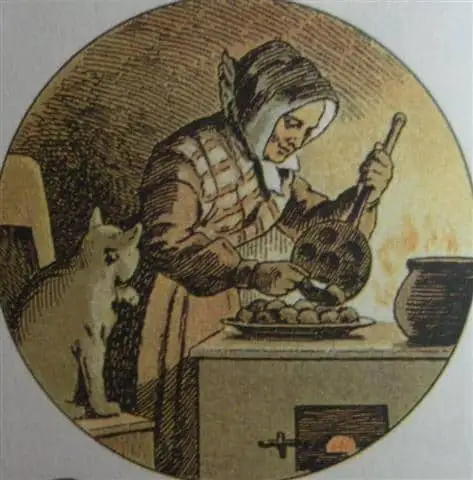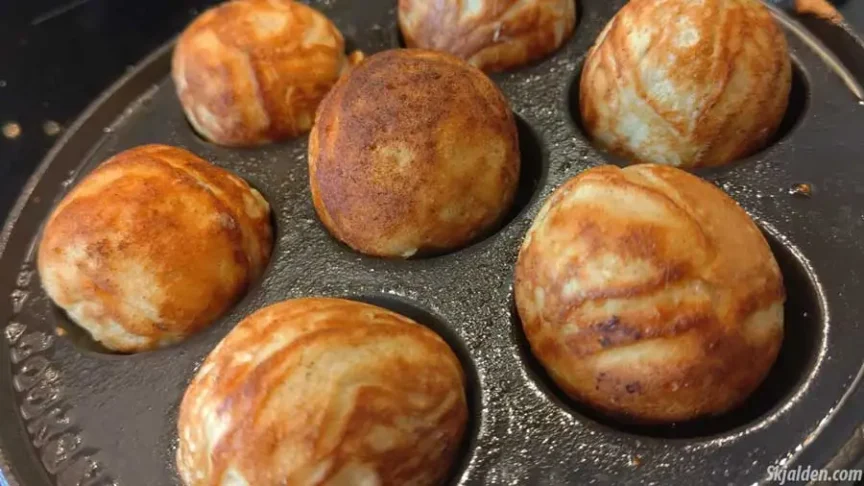Æbleskiver, often translated as “apple slices” from Danish, are traditional pancake-like treats eaten traditionally during the Christmas season. These treats have been a part of Danish culture since the 17th century, evolving over the years from being filled with actual apple slices to the more varied fillings and flavors we see today.
Apple slices were traditionally included in Æbleskiver recipes from the 17th century up to the early 19th century but are no longer a common ingredient today. Nevertheless, some regions in Denmark, such as Sønderjylland and the island of Ærø, continue to add fruit, like prune pulp, to their Æbleskiver.
Pronouncing Æbleskiver ([ˈɛːpləˌskiːʊ̯ɐʁ]) can be challenging for non-natives, and it’s often anglicized to “Aebleskiver” for ease. In English, the letter “Æ” translates to “AE,” making it correct to write Æbleskiver as Aebleskiver. Æbleskiver is used for the plural form, and Æbleskive is for the singular.
Æbleskiver’s name and form have interesting origins and have been subject to many culinary myths, including an entertaining yet historically inaccurate tale involving Vikings using their damaged shields as cooking tools. This fanciful story suggests that after a battle, Vikings mixed flour, milk, and sugar and cooked the batter on their shields. Despite its appeal, this narrative does not align with historical facts, as the specialized Æbleskive pan was developed long after the Viking age.

Æbleskiver in Denmark and Beyond
In Denmark, Æbleskiver are a must-have during the holiday season, often enjoyed as a warm afternoon snack or a post-dinner treat. If you find yourself in Denmark during December, visiting a Christmas market will almost guarantee you’ll encounter these tasty treats, freshly made and ready to enjoy.
While Æbleskiver are Danish, similar dishes can be found in neighboring countries, but under different names and with slight variations:
Norway: Known as “Munker,” linked to monastic traditions where monks were known to prepare these treats.
Sweden: Called “Munkar,” which is similar in name but refers more to a donut-like pastry rather than the Danish treat.
Germany and the Netherlands: In Northern Germany, they are referred to as “Futjes” and in the Netherlands, “Poffertjes,” which are smaller and not round like Æbleskiver but share some preparation methods.
Traditionally, Æbleskiver are prepared in a distinctive cast iron pan known as an Æbleskivepande, which often doubles as a decorative item in Danish kitchens when not in use. The modern recipe for Æbleskiver has evolved to resemble more of a pancake batter, occasionally enhanced with spices like cardamom to give it a festive twist.
Not all Danes make Æbleskiver from scratch; many opt for the convenience of deep-frozen ones available in supermarkets throughout Denmark, especially in December. These can be quickly warmed in the oven. If you’re in Denmark during the holiday season, try the Karen Voff brand for quality deep-frozen Æbleskiver. Don’t forget to grab some jam to enjoy with them—choose your favorite flavor.

Classic Recipes Through the Ages
Æbleskiver Recipe from 1710:
This recipe provides a glimpse into how Æbleskiver was enjoyed historically, featuring ingredients that were commonly used in early recipes. This recipe is the same as the one they use in the old town (Den Gamle By) in Aarhus, Denmark during Christmas.
- Ingredients: 500 grams of wheat flour, 5 eggs, 12 grams of yeast, 2 tablespoons of sweet wine (like Port), 1 deciliter of cream, and 2-3 apples, finely chopped.
- Method: Combine eggs and wine in a bowl, gradually adding flour. Dissolve yeast in warm water and add to the mixture. Heat cream slightly and mix into the dough. Add chopped apples if desired. Cook the batter in an Æbleskive pan, turning with a knitting needle to achieve a round shape.
Æbleskiver Recipe from 1888:
From “Louise Nimbs kogebogen,” this recipe reflects a slightly more modern adaptation but still holds true to traditional methods:
- Ingredients: 500 grams of wheat flour, 1 teaspoon of sugar, 1/2 teaspoon of cardamom, 1/2 liter of lukewarm milk, 3 egg yolks, 25 grams of yeast, butter for cooking, and apple sauce.
- Method: Mix flour, sugar, and cardamom. Stir in milk, add egg yolks and yeast. Let the dough rise. Before baking, whip egg whites and fold them into the dough. Cook in an Æbleskive pan with a little butter, adding apple sauce as they begin to brown.
Present-Day Recipe:
Today, the process for making Æbleskiver might use a simplified batter similar to pancake mix, omitting the apple slices that gave the treats their original name but sometimes including other fruit like prune pulp or even a sweet filling like jam.
- Ingredients: 250 grams of wheat flour, 4 dl buttermilk, 3 eggs, 1 tablespoon of sugar, 1/2 teaspoon of baking soda, 1/4 teaspoon of coarse salt, 3 tablespoons of melted butter.
- Method: Separate the eggs and whip the whites. Mix yolks with buttermilk and sugar. Combine flour, baking soda, and salt, then blend into the liquid ingredients. Fold in whipped egg whites. Cook in a preheated Æbleskiver pan, turning carefully to ensure even cooking.
Æbleskiver are traditionally served warm, straight from the pan, often accompanied by powdered sugar and jam, and sometimes enjoyed with Gløgg, a Scandinavian mulled wine.
